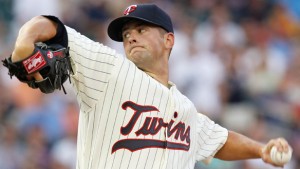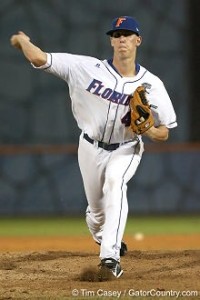To a certain small degree (very small, actually), I find the discussions about the MLB draft entertaining. Sure, it will be mildly interesting to see who the Twins draft with the #2 pick overall tonight in the first round of this year’s Amateur Draft and it will be much more entertaining to read the inevitable explosion of comments from the self-anointed “experts” in online Twinsville, all telling us how badly the Twins screwed up with their pick.
But, frankly, I just don’t care that much who they pick. Make that, I just don’t care AT ALL who they pick. Once the pick is made and the young man, whoever it is, signs with the Twins, then I’ll be interested in following his progress within the organization’s minor league system.
But all the people who are going on and on about how this pick is some kind of turning point for the organization or how they need to be drafting the next “face of the franchise” need to just take a chill pill. The MLB draft is a lot like playing roulette. There is absolutely no certainty that any specific draft pick will eventually even play in the Majors, much less become a star.
The first round is comparable to picking red or black on the roulette wheel. At best, you’ve got just below a 50-50 shot at your choice being a winner. After that, it becomes more like putting your money on increasingly smaller groups of numbers, making your odds longer and longer, until you get to the point where your chances of hitting on a late round pick are worse than just putting your hard-earned money on a single number on the wheel.
In fact, despite the draft going 50 rounds prior to this season, when it’s been cut to 40, you seem to see just about as many non-drafted players beating the odds as you do guys who were drafted pretty much anywhere outside the top few rounds.
For a case in point, let’s take a look at a couple of young pitchers that Twins fans may recognize.
Pitcher A was drafted not once, but twice. He was drafted in the 20th round by the Dodgers out of high school in 2006, but opted to pitch for a big-time college program. In 2009, he was drafted in the second round by the Twins.
Pitcher B is a year older than pitcher A, but was never drafted. After pitching for Binghamton University in NY, he signed a contract with Atlanta after his junior year of college in 2008. Just before the opening of the 2011 season, this young pitcher was traded to the Twins for Pitcher A.
Today, Pitcher A is sporting a not-too-nifty 1.714 WHIP for the Braves’ AA team in Mississippi, where he’s giving up 7.7 hits per nine innings and is walking an identical 7.7 batters per 9… which is actually more hitters than he’s striking out in each nine innings of work.
Sunday, Pitcher B pitched seven strong innings for the Twins without giving up any earned runs, dropping his ERA to below two earned runs per nine innings. His WHIP is 1.190 and while he’s giving up a few more hits than we might like to see (9.8 per 9 IP), he’s walking less than one hitter per 9.

By now, pretty much everyone still bothering to read this knows I’m writing about Scott Diamond, who the Twins acquired in the Rule 5 draft before the 2011 season and subsequently traded second round draft pick Billy Bullock to the Braves for, in order to be able to send Diamond to the minors before the 2011 season started.
It’s still far too soon to tell what the future holds for these two young pitchers’ careers. Diamond is still 25 for a few weeks and Bullock turned just 24 earlier this year. They’re still young enough for us to debate “ceilings” and “potential” if we want to get in to a discussion about whether the trade was good or bad.

It could also be argued that I’ve cherry-picked a bit to make this comparison… that there are just as many examples (and probably many more) available that would demonstrate that high draft picks are much more likely to contribute at the Major League level than players who were never drafted. I’ll plead guilty to the cherry-picking, too.
But my point is simply this… go ahead and follow the MLB draft tonight and over the next few days and feel free to express your views about how the Twins coulda-shoulda-woulda been better off drafting this guy over that guy. But realize that in the grand scheme of things, nobody has a friggin clue who the “right” picks are… and we won’t find out for years.
But hey, if you’re one of those people who really don’t mind watching the little silver ball go round and round the roulette wheel for 3-4 years before it lands, knock yourself out!
– JC

Your points are well-taken, especially when you compare this year’s draft to the past couple.
Bryce Harper and Steven Strasburg weren’t 100 percent guarantees to become successful players, but you had a pretty good idea that they would make it in a relatively short period of time, barring unforseen circumstances. There’s no player this year that seems close to equivalent.
I agree, AW, that some years there are guys who appear MUCH more likely to become stars. Then again, if Washington had known Strasburg would need TJ surgery so soon, do you think they would have still considered him a sure thing? And as I recall, there was a lot of discussion about Harper’s “attitude” that people were bringing up as a red flag. It’s those “unforseen circumstances” that play a large part in the draft being such a crapshoot.
I really have no idea about anybody in the draft, and I don’t think any bloggers have a real clue, either. Each year, I just hope not to see the Twins pick another “toolsy” player who has never shown any power. But I expect MLB scouting directors to show a higher level of expertise. It has to be embarrassing when they have a Top 5 pick and whiff on it, anyway.
I agree, frightwig, though the “power” thing can be a bit misleading. While it didn’t take a genius to look at Ben Revere coming out of school and know he wouldn’t develop power, sometimes it isn’t that easy. Star HS position players (and even many college players on mediocre teams) often get pretty much nothing to hit once word of their talent gets around. Even a guy like Miguel Sano, who’s playing Class A baseball, is getting virtually no fastballs in the strike zone to swing at any more and he’s facing supposedly professional level pitchers that think they have a shot at playing Major League baseball some day. I do agree, however, that a position player drafted with the #2 pick overall had better project to have power at the plate.
As for it being embarrassing when a staff whiffs on a high draft pick, yeah… but it depends a bit on the reason for the whiff. You can’t easily predict injuries (though you should probably be cautious about college pitchers that have coaches who abuse them significantly), so I only consider it a real whiff it the player simply doesn’t ever develop Major League skills. If his failure is injury related, that’s hard to blame scouts for unless there was some indication of a problem at the time of the draft.